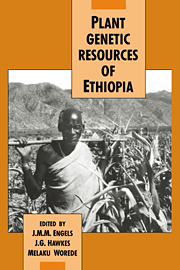Book contents
- Frontmatter
- Contents
- Contributors
- List of acronyms
- Preface
- Part I General introduction
- Part II The Ethiopian centre of diversity
- Part III Germplasm collection and conservation in Ethiopia
- Part IV Evaluation and utilization of Ethiopian genetic resources
- 18 Germplasm evaluation with special reference to the role of taxonomy in genebanks
- 19 Crop germplasm multiplication, characterization, evaluation and utilization at PGRC/E
- 20 Evaluation methods and utilization of germplasm of annual crop species
- 21 Evaluation and utilization of Ethiopian forage species
- 22 Improvement of indigenous durum wheat landraces in Ethiopia
- 23 Use of germplasm resources in breeding wheat for disease resistance
- 24 Indigenous barley germplasm in the Ethiopian breeding programme
- 25 The role of Ethiopian sorghum germplasm resources in the national breeding programme
- 26 Germplasm evaluation and breeding work on teff (Eragrostis tef) in Ethiopia
- 27 Pulse crops of Ethiopia: genetic resources and their utilization
- 28 Oil crop germplasm: a vital resource for the plant breeder
- 29 Significance of Ethiopian coffee genetic resources to coffee improvement
- 30 Use of Ethiopian germplasm in national and international programmes
- Index
21 - Evaluation and utilization of Ethiopian forage species
Published online by Cambridge University Press: 30 October 2009
- Frontmatter
- Contents
- Contributors
- List of acronyms
- Preface
- Part I General introduction
- Part II The Ethiopian centre of diversity
- Part III Germplasm collection and conservation in Ethiopia
- Part IV Evaluation and utilization of Ethiopian genetic resources
- 18 Germplasm evaluation with special reference to the role of taxonomy in genebanks
- 19 Crop germplasm multiplication, characterization, evaluation and utilization at PGRC/E
- 20 Evaluation methods and utilization of germplasm of annual crop species
- 21 Evaluation and utilization of Ethiopian forage species
- 22 Improvement of indigenous durum wheat landraces in Ethiopia
- 23 Use of germplasm resources in breeding wheat for disease resistance
- 24 Indigenous barley germplasm in the Ethiopian breeding programme
- 25 The role of Ethiopian sorghum germplasm resources in the national breeding programme
- 26 Germplasm evaluation and breeding work on teff (Eragrostis tef) in Ethiopia
- 27 Pulse crops of Ethiopia: genetic resources and their utilization
- 28 Oil crop germplasm: a vital resource for the plant breeder
- 29 Significance of Ethiopian coffee genetic resources to coffee improvement
- 30 Use of Ethiopian germplasm in national and international programmes
- Index
Summary
Introduction
Plants which are utilized as fodder for livestock are confined to those which can provide maximum yields in animal production with minimum management inputs. Such plants are usually members of the families Gramineae and Leguminosae and are mainly herbs or subshrubs. In recent years leguminous shrub and tree species have been receiving increasing attention, particularly for small farmers in developing countries.
The Gramineae and Leguminosae are major sources of human nutrition as cereals and pulses while the by-products of these crops are major sources of nutrition for livestock. This report will be confined, however, to plants which are planted primarily as livestock fodder.
Ethiopia, as part of the African continent, shares many genera and species of grasses and legumes with the rest of the continent. However, its great variations in climate and relief and its heavily dissected landscape have provided the opportunity for further evolution of species and genotypes. About 64 species of legumes, mainly montane (10–11 per cent of the total), have been reported as probably being endemic to Ethiopia, while 30 species of grasses are endemic (Thulin, 1983).
African grasses are the main source of cultivated commercial grass species and cultivars in the tropics and subtropics worldwide and are almost all represented in Ethiopia. While Africa is not the major centre of diversity in legumes it is a major centre of diversity for such genera of fodder potential as Aeschynomene, Alysicarpus, Indigofera, Lablab, Lotononis, Macrotyloma, Neonotonia, Trifolium and Vigna.
- Type
- Chapter
- Information
- Plant Genetic Resources of Ethiopia , pp. 278 - 287Publisher: Cambridge University PressPrint publication year: 1991
- 1
- Cited by

